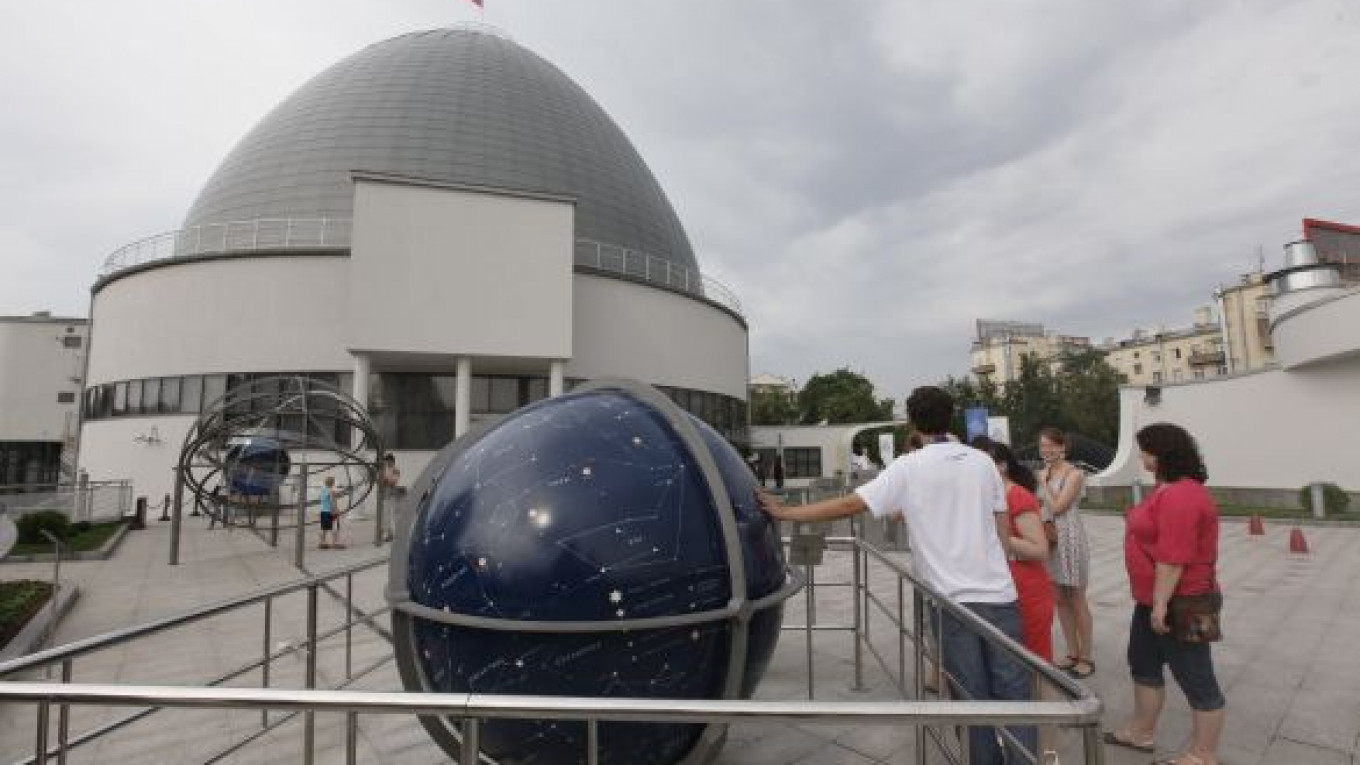"With the naked eye you'd just see one star," said the astronomer as he bent over the telescope. "There are two here, each of a different color — the yellow-green one is the main one, the blue one is its satellite."
He continued as he adjusted the lens: "It is a double star of Gamma Andromedae. Its light takes 400 years to get to Earth. In other words, the light is from when the Time of Troubles took place in Russia."
The astronomers at the Moscow planetarium's outdoor area try and speak as simply as possible so that even children can understand them. Indeed, among the visitors who turn up for the start of sky observation at 9 p.m. are families with children.
Anyone can turn up on Monday, Wednesday and Friday evenings until the end of September to take a look at the stars and ask the planetarium's professional skygazers' questions. That does depend on the weather, of course. Two hours before the start, the planetarium's website posts a notice that tells you whether it is worth turning up or not.
The telescope sessions are part of an international action where planetariums open up in different countries for free during the best month for sky watching.
Fifty people crowded round on the planetarium's first open evening earlier this month. The sky was still light but cloudy. This did not bother the planetarium's staff, who divided the visitors into two groups and took us to a square filled with sundials, astronomical instruments and globes of the Earth and the starry sky.
"What do you think? Why is there a constellation called Lynx when it doesn't look like one," our guide asked as his finger pointed to a spot on a dark map.
Our group didn't say a word. Neither I nor anyone else wanted to confess that nothing in the night looks like anything on Earth; no ploughs, no lions, no hunters.
"The thing is, it is one of the dimmest constellations. There is not one bright star there, and the scientist who gave it that name thought that you needed the eyes of a lynx to see it."
Half an hour later, the sky cleared up and the astronomers called us to the telescopes. There were about six or seven on the square and small queues were quickly formed behind each of them. I was in the queue to see the double star Albireo in the Swan constellation. Bending over to the telescope, the sky above was gray with а few clouds, but looking into the telescope I saw darkness, and within that dark two bright stars: one yellow, one light blue.
It was so unexpected that it felt unreal, fake. I looked around Albireo as the double star moved out of view. The Earth was rotating so quickly that you could notice its movement in the telescope.
The astronomer focused the telescope for the next person and I got in the queue for the next one — to see the moon.
"Your lens is sweating. You can see clearly some drops in the middle," rebuked a bearded visitor. "It gets in the way."
The astronomer took off the lens and looked at the glass. He then accurately returned it to its place and didactively said: "The bit in the center is not on the lens but on the moon. It is a crater and not drops, you know."
"But why is it so even and light?" asked the bearded one.
"The lighter the crater, the younger it is," explained the astronomer. "The darker ones were formed when the moon was still hot and lava appeared on its surface."
The longest queue was at the large observatory, which has the biggest telescope with a magnification rate of 265 times; the ones on the street magnify by 50 to 70 times depending on the lens.
Groups of 30 people are let in at a time, but you still needed to wait for about an hour to get in. Many people popped out of the queue to look through the street telescopes once more or to use the astronomic binoculars, which anyone can use without supervision.
"The old lady is preparing dinner," says one girl to her friend as she trained the binoculars on a house nearby. "If I were in her place, I would have long ago prepared a striptease for the planetarium visitors."
"A man on the balcony is taking photos of me," said another before pointing the binoculars at the Stalin-era skyscraper near Barrikadnaya metro station. "There are such amazing flats here."
When I made it into the observatory, the sky was full of clouds again.
"In that case we will use the telescope to look at the star that is always easy to see — the star on the skyscraper at Barrikadnaya," our guide said.
Moscow Planetarium. 5 Sadovaya-Kudrinskaya Ulitsa, Bldg. 1. Metro Barrikadnaya. Tel. +7 (495) 221-7690.
Related articles:
A Message from The Moscow Times:
Dear readers,
We are facing unprecedented challenges. Russia's Prosecutor General's Office has designated The Moscow Times as an "undesirable" organization, criminalizing our work and putting our staff at risk of prosecution. This follows our earlier unjust labeling as a "foreign agent."
These actions are direct attempts to silence independent journalism in Russia. The authorities claim our work "discredits the decisions of the Russian leadership." We see things differently: we strive to provide accurate, unbiased reporting on Russia.
We, the journalists of The Moscow Times, refuse to be silenced. But to continue our work, we need your help.
Your support, no matter how small, makes a world of difference. If you can, please support us monthly starting from just $2. It's quick to set up, and every contribution makes a significant impact.
By supporting The Moscow Times, you're defending open, independent journalism in the face of repression. Thank you for standing with us.
Remind me later.






